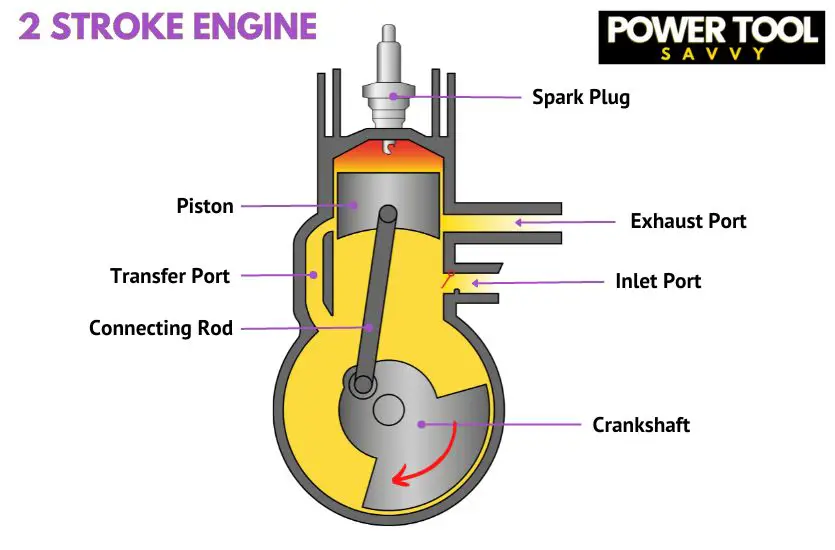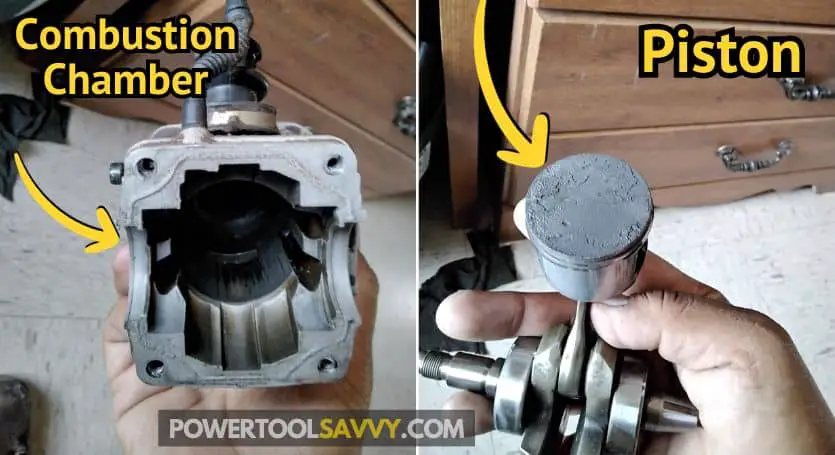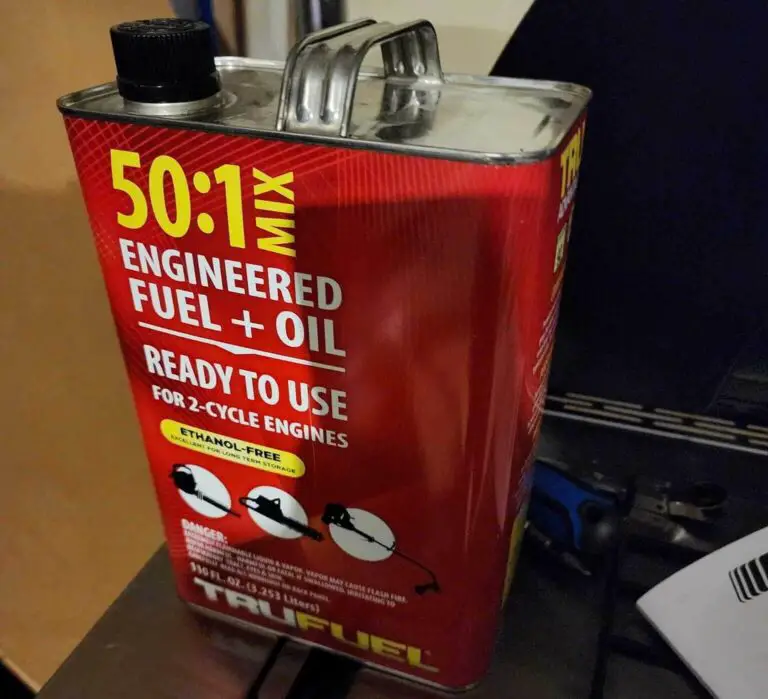
Yes, almost all the gas-powered modern chainsaws are 2-stroke. This is because, 2-stroke engines are typically lighter, simpler, and have a higher power-to-weight ratio than 4-stroke engines, which is crucial for handheld tools like chainsaws.
Btw, I’m Sam, and I have over two decades of experience working with chainsaws. In this article, I’m going to cover – 👇
- ✅ what 2-stroke engines are & how they are different from 4-stroke engines,
- ✅ the PROS and CONS of 2-stroke chainsaws,
- ✅ tips for maintaining your 2-stroke chainsaw to ensure optimal performance.
Are you ready??
Let’s dive in!
Table of Contents
ToggleWhat is a 2-Stroke Engine & How Does It Work?
As the name suggests, a 2-stroke engine is an internal combustion engine that requires two piston movements or strokes (up and down) to complete one power cycle.

- Compression Stroke: The air-fuel mixture enters the chamber through the inlet port, and the piston goes up, squishing this mixture.
- Combustion Stroke: The spark plug ignites the mixture, creating a big explosion that pushes the piston down and generates power.
This cycle repeats continuously, generating power and making the engine run.
2-Stroke VS 4-Stroke Engines: Differences
Below is a clear & simple table highlighting the key differences between 2-stroke and 4-stroke engines: 👇
| ASPECT | 2-STROKE ENGINE | 4-STROKE ENGINE |
|---|---|---|
| Cycles | 2-stroke engines require two piston movements (up & down) to complete one cycle: compression and combustion. | 4-stroke engines require four piston movements (up, down, up, down) to complete one cycle: intake, compression, combustion, and exhaust. |
| Fuel Efficiency | 2-stroke engines are less fuel efficient. | 4-stroke engines are more fuel-efficient (as they consume fuel once every four strokes). |
| Power | 2-stroke engines produce more power for its size. | 4-stroke engines are less powerful (but they offer better torque & smooth power output). |
| Lubrication | 2-stroke engines require oil to be mixed with fuel for lubrication. | 4-stroke engines have a separate oil reservoir. |
| Weight & Size | 2-stroke engines are smaller and lighter. | On average, 4-stroke engines are 50% heavier than 2-stroke engines. |
| Maintenance | 2-stroke engines have a simpler design with fewer moving parts, making them easier to maintain. (But they require more frequent maintenance!) | 4-stroke engines are more expensive to repair as they have a complex design with tons of moving parts. |
| Noise & Vibration | Louder and vibrate more due to frequent power strokes. | Usually quieter and have less vibration. |
| Application | Commonly used in dirt bikes, jet skis, lawnmowers, smaller motors, etc. | Mainly used in automobiles, trucks, motorbikes, go-karts, etc. |
Why Are Chainsaws 2-Stroke?
Below are the 3 primary reasons why chainsaws typically use 2-stroke engines: 👇
2-Stroke Engines are Lightweight & Compact
Ever wondered how chainsaws manage to be lightweight and compact, while still being so damn powerful? (It’s pretty amazing, right?)
Well, it’s thanks to their 2-stroke engines!
The design of a 2-stroke engine is much simpler and more compact than its 4-stroke big brother. This makes it perfect for tools like chainsaws, where portability is a TOP priority.
Plus, a 2-stroke engine has only three moving parts (the piston, connecting rod, and crankshaft), whereas a 4-stroke engine has five (the piston, connecting rod, crankshaft, camshaft, and valves).
Fewer moving parts = less weight + less complexity = WIN! 🎉

On top of it, 2-stroke engines don’t need a separate lubrication system, which also saves on space and weight!
2-Stroke Engines are More Powerful
2-stroke engines are like those “overachieving” siblings who always seem to get twice the amount done in half the time!
You see, for every rotation of the crankshaft, a 2-stroke engine produces power once. Meanwhile, a 4-stroke engine requires two crankshaft rotations to complete one power cycle.
This means that a 2-stroke engine produces twice the amount of power in the same amount of time as a 4-stroke engine.
And because chainsaws are tools that require a lot of power (while still being lightweight & compact), 2-stroke engines are the perfect fit!
2-Stroke Engines are Easier to Maintain
Let’s be real!
No one likes spending hours trying to fix something. And when it comes to tools like chainsaws, downtime is simply not an option!
That’s why having a simpler engine design makes maintenance and repairs so much easier and faster! (There are fewer parts to troubleshoot, diagnose, and replace.)
Plus, since there’s NO separate lubrication system, you don’t have to worry about oil changes or other maintenance tasks related to it.
The bottom line??
2-stroke engines are the perfect choice for chainsaws. They offer a balance of power, portability, and ease of maintenance!
Common Issues with 2-Stroke Engines
Despite all their perks, 2-stroke engines aren’t without their quirks and potential issues. (I mean, nothing’s perfect, right?)
Here are the 5 most common issues you might encounter with a 2-stroke chainsaw engine: 👇
- 2-stroke engines are not as fuel-efficient as 4-stroke engines. They consume more fuel because they have to perform the power cycle twice as often.
- They can be a bit noisy so be sure to use ear protection when operating a chainsaw! (Learn more: How Loud are 2-Stroke Chainsaws?)
- 2-stroke engines require premixing of fuel and oil at a specific ratio, which can be tedious and messy for some users.
- Since 2-stroke engines are designed to run at high RPMs, they tend to wear out faster compared to 4-stroke engines.
- Last but not least, 2-stroke engines are not as environmentally friendly as 4-stroke engines. They release more emissions into the air, contributing to pollution.
Tbh, these are basically minor inconveniences compared to the overall benefits of a 2-stroke chainsaw.
But it’s always GOOD to be aware of any potential issues!
Are There Any 4-Stroke Chainsaws?
As of now, there are no commercially available 4-stroke chainsaws. This is because, 4-stroke engines are usually heavier, bulkier, more expensive, and have a lower power-to-weight ratio.
4-stroke engines are typically found in cars, dirt bikes, lawnmowers, and other larger vehicles and equipment where weight & size are not as “critical” as they would be in a chainsaw.
But can we expect 4-stroke chainsaws in the future?
Maybe!
In fact, STIHL has already started developing a “hybrid” 4-stroke engine for their chainsaws that combines the best of both 2-stroke and 4-stroke engines. They’re calling it the STIHL 4-MIX engine.
STIHL claims that it will run on a standard fuel-oil mix like a 2-stroke engine but with the added benefits of lower emissions, better fuel efficiency, and quieter operation.
(Check this article by STIHL to learn more about this engine!)
2-Stroke Chainsaw Fuel Mix Ratio

Alright, so we already know that a 2-stroke engine requires premixing of fuel and oil. But what is the RIGHT ratio?
For most modern chainsaws, the recommended fuel-oil mix ratio is 50:1. This means that for every gallon of gasoline, you’ll need to add 2.6 ounces (or about 74 ml) of oil.
| MIX RATIO TO 1 | 1 GAL. | 2 GAL. | 2.5 GAL. | 4 GAL. |
|---|---|---|---|---|
| 50 | 2.6 oz. | 5.1 oz. | 6.4 oz. | 12.8 oz. |
But here’s the thing…
Different chainsaws can have different ratios depending on their brand & model!
So always check your owner’s manual or the manufacturer’s website for the correct mix ratio.
Tips for Maintaining Your 2-Stroke Chainsaw
If you want your 2-stroke chainsaw to last a long time (and perform at its BEST), you need to take good care of it!
Here are 7 quick tips for maintaining your 2-stroke chainsaw: 👇
- ✅ Always use high-quality fuel and oil in your chainsaw at the recommended mix ratio.
- ✅ Use fresh fuel, as in, no more than a month old!
- ✅ Use a fuel stabilizer if you plan on leaving your chainsaw sitting for a month or more! This will prevent the fuel from breaking down and causing clogs in your engine.
- ✅ Clean or replace air filters regularly. Dirty or clogged air filters can affect engine performance and lead to costly damage!
- ✅ Check the spark plug regularly and replace it if necessary.
- ✅ Make sure the engine compression is at the proper level. (check this article to learn more about chainsaw engine compression!)
- ✅ Store your chainsaw in a clean, dry place away from moisture and extreme temperatures.





Pingback: Chainsaw Smoking? Here are 5 EASY Fixes!